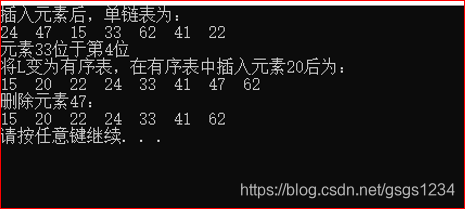@【数据结构】(链表)
链表基本操作函数,完成带头结点的链表函数的定义
链表长度,链表元素输出,查找第i个节点的指针,指定位置插入元素, 查找某元素的链表结点位置
#include<stdio.h>
#include<iostream>
using namespace std;
typedef struct list
{
int data;
struct list *next;
}*LIST, LNode;
void InitList(LIST *L) /* 初始化链表 */
{
*L = (LNode *)malloc(sizeof(LNode)); //带头结点的链表初始化
(*L)->next = NULL;
}
int Length(LIST L) //带头结点的单链表长度
{
LNode *p = L; //p指向头结点
int j = 0;
while (p->next!=NULL)
{
p = p->next; j++;
}
return j;
}
void OutputList(LIST L)
{
LNode *p;
p = L->next;
while (p)
{
cout << p->data << " ";
p = p->next;
}
}
//*查找第i个节点的指针
LNode *Find(LIST L, int i)
{
LNode *p = L;
int j = 0;
while ((p->next != NULL) && (j < i))
{
p = p->next; j++;
}
if (i == j) return(p);
else return NULL;
}
void InsertList1(LIST L, int item, int rc)
/* 向链表指定位置[rc]插入元素[item] */
{
LNode *p,*s;
p = Find(L, rc- 1);
if (!p)
cout << "error:without" << endl; //参数不合法
else
{
s= (LNode*)malloc(sizeof(LNode));
s->data= item; //创建新元素的结点
s->next = p->next;
p->next = s; //修改指针
}
}
void order(LIST L) //排序,链表变为升序
{
LNode *pre, *q, *l1, *l2;
l1 = L->next;
q = l1->next;
l1->next = NULL; //将原来的链L断开
while (q)
{
l2 = q;
q = q->next;
pre = L; //pre是待插入位置的前驱
l1 = L->next; //l1是待插入位置的后继
while (l1 != NULL && l1->data < l2->data) //寻找合适的插入点
{
pre = l1;
l1 = l1->next;
}
//插入合适位置
l2->next = l1;
pre->next = l2;
}
}
void InsertList2(LIST L, int item)
/* 向有序链表L插入键值为[item]的结点 */
{
order(L);
LNode *p,*q,*s;
p = L; q= p->next;
while (q&&q->data < item) //找到插入的地方
{
p = p->next; q = q->next;
}
s = (LNode*)malloc(sizeof(LNode));
s->data = item;
s->next = q;
p->next = s;
cout << "将L变为有序表,在有序表中插入元素" << item << "后为:" << endl;
OutputList(L);
}
/* 查找键值为[item]的链表结点位置, 返回>=1: 找到 -1: 没找到 */
int FindList(LIST L, int item)
{
LNode *p = L;
int j = 0;
while ((p->next) && (p->data != item))
{
p = p->next; j++;
}
if (p->data == item) return j;
else return -1;
}
/* 删除键值为[item]的链表结点, 返回0: 删除成功 1: 没找到 */
int DeleteList(LIST L, int item)
{
LIST p,s;
int i = FindList(L, item); //查找键值为[item]的链表结点位置
p= Find(L, i - 1); //键值为item的结点前一个结点的指针
if ((p != NULL) && (p->next != NULL))
{
s = p->next; //指向第i个节点
p->next = s->next;
free(s);
return 0;
}
else return 1;
}
//输出链表元素
void main()
{
LIST L;
LNode *p;
InitList(&L);
p = L;
int item;
cout << "插入元素后,单链表为:" << endl;
InsertList1(L, 24, 1);
InsertList1(L, 47, 2);
InsertList1(L, 15, 3);
InsertList1(L, 33, 4);
InsertList1(L, 62, 5);
InsertList1(L, 41, 6);
InsertList1(L, 22, 7);
OutputList(L);
cout << endl;
item = 33;
cout << "元素33位于第" << FindList(L, 33) << "位" << endl;
InsertList2(L, 11);
cout << "插入键值为11的结点后" << endl;
OutputList(L);
cout << endl;
DeleteList(L, 47);
cout << "删除元素47:" << endl;
OutputList(L);
cout << endl;
system("pause");
}
注:链表中的元素是InsertList1(L, X, i)逐个插入的,链表中的元素已预定义好。
测试示例:

